All through my childhood I had a recurring dream that if I buried rubbish on the side of our road and came back later it would turn into treasure. I was always scanning the bush for anything different or unusual that could be a sign of hidden treasure. I feel like I have gone on in my career to transform materials into treasures.
Sculptor Minka Gillian recounts hitting rock bottom after a pacemaker implant and realising that art was her true life blood, while on the road to recovery. In a conversation with Sonalee Tomar, she talks about the sculptures she makes with found objects.
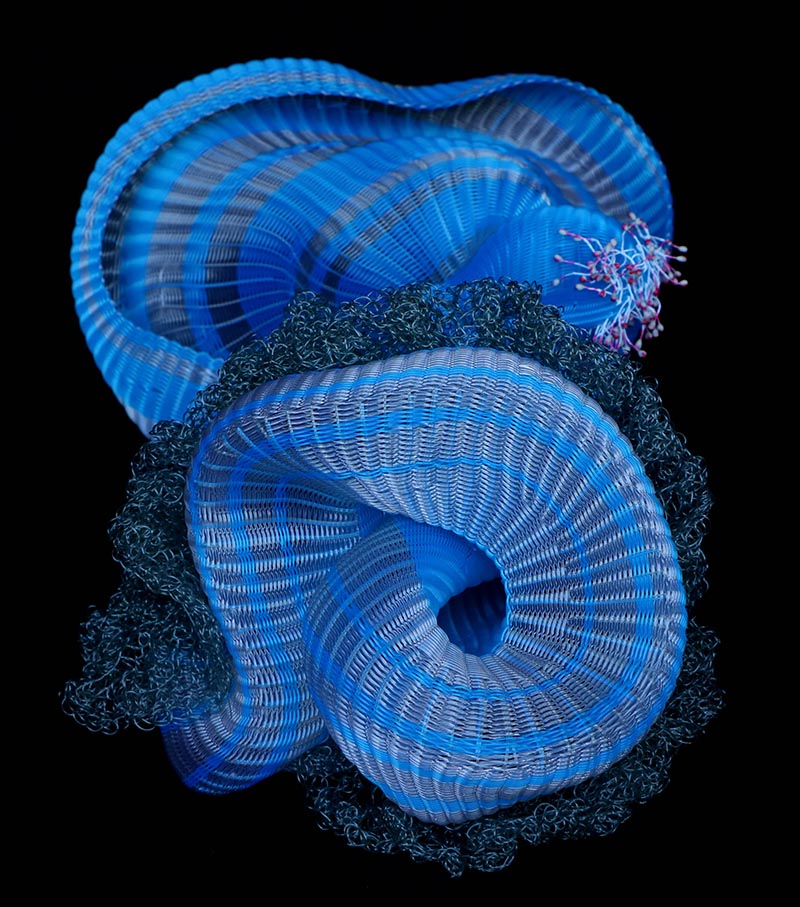
Flow
Let us start from the start. How did your tryst with art begin?
I grew up in a picturesque valley in Tasmania in between two creeks in the bush. I was a child that learnt through touch and action, so being surrounded by nature was a great learning experience.
Cold weather most of the year forced me to think up indoor pursuits, and my creative and frugal parents were always there to help. The handmade and unique are valued and encouraged in my family. My parents both did craft in various forms and they are both keen basket makers.
I have always been a social person and an over-thinker, so art making was my salve. It forced me to turn inwards, quieten my mind and, through the action of physically doing something, make solid my more inexpressible emotions.
I feel untethered without the concentration of art making. So, it was always something I wanted and had to do, a way of creating order out of chaos.
Leafing through our families’ copies of National Geographic magazines, I was fascinated by archeological digs, mummified bodies and uncovered treasures but the magazine that has stayed with me was The Fascinating World of Trash, the 1983 edition starring Larry Fuente, who transformed everyday items into wacky objects of intrigue.
All through my childhood I had a recurring dream that if I buried rubbish on the side of our road and came back later it would turn into treasure. I was always scanning the bush for anything different or unusual that could be a sign of hidden treasure. I feel like I have gone on in my career to transform materials into treasures. I remember making a conscious decision that I was going to be an artist when I was 14 years old.
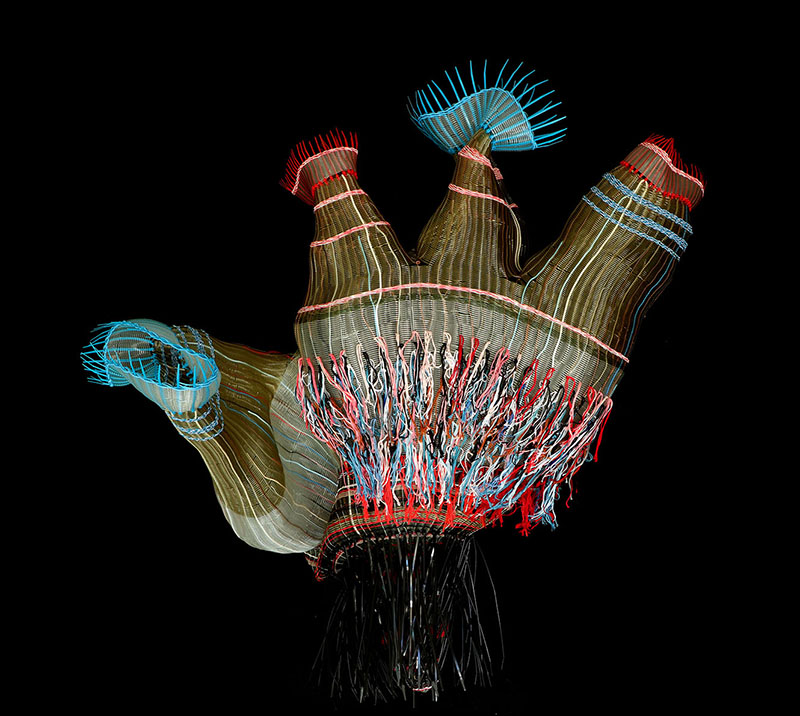
Ghost Heart
Tell us about the evolution of your practice over the years.
My childhood idea of what an artist is was limited to the romantic idea of being a poor starving painter. I loved painting, drawing and printmaking but felt frustrated as I couldn’t convey what I was trying to express in those mediums.
Sculpture wasn’t something I’d thought about initially but when I realised sculpture wasn’t only carving stone and casting bronze, I fell in love with it.
I don’t like being limited to techniques that require machinery or expensive materials. So, sculpture using found objects, materials from nature and collections of everyday materials and simple craft techniques like sewing and weaving felt like a very comfortable move for me. This is not to say it isn’t without its difficulties and frustrations, but the rewards felt greater.
At art school I was initially interested in the body and sexuality and created installations out of found objects and sex toys. Later I moved onto voodoo style dolls woven out of human hair and New Zealand flax. I loved having the ability to make art out of materials growing nearby that cost me nothing, but I developed an allergy to flax so had to give it up. My lecturer at the time suggested plastic which I wasn’t keen on using as my mother was allergic to plastic and I grew up in a household without it. I have never looked back!

One in a million
Tell us about the greatest lessons and obstacles that you encountered along the way. Which is the most memorable moment?
One of my biggest setbacks was when I was 35 with a young baby. An opportunity to have a solo show came up but I only had three months to get it all together. I didn’t even know I if could work that quickly but I was so desperate to prove that motherhood hadn’t made me invisible or irrelevant.
I finished all the work a bit ahead of schedule but the strain of motherhood, the immense pressure I put on myself and my neglect of my general health became too much for me and a pre-existing heart problem resurfaced and I ended up in the hospital. I had to get a pacemaker implanted. The worst part in my eyes was that the hospital wouldn’t let me out to go to my exhibition opening! I even said I would sign a waiver stating it wasn’t their fault if I died. The only time I got to see the show was on the last day. The following month after the operation has been completely blanked out from my mind.
The fight back to a “normal” art routine and coming to terms with my now bionic nature took me quite a few years and a fair bit of anger and frustration. Lots of well-meaning non-artist mothers would say “it’s only four years!” Four years without focused dedication to art sounded like slow death to me.
After the pacemaker I had a strong feeling that “everything had changed, and nothing had changed” moving forward, as if it was all the same didn’t make sense to me anymore. I felt I needed a new language to “deal” with the things that had happened to me. I had a very strong scene in my head of me walking through two brick walls that were funneling me to a point on the edge of a cliff overlooking the sea. I could see the bright blue sky, but I couldn’t walk any further because there was a glass wall at the end of the cliff. I felt the sky was my future, but I couldn’t get to it anymore. You couldn’t see the blockage because it was glass, but it had made me come to a full stop.
I have had the endless support of a good husband and my son was a wonderful baby and toddler, so that helped to make things easier. But I felt like I was always in a constant state of failure. I was either being a crap mum or a crap artist. The pressure and guilt I put on myself was massive.
I feel like I didn’t achieve a good routine since my son started school.
Good documentation of your work is essential as it shows your professional commitment, photos go on to live lives in magazines and books and often get seen more than the original artwork. Artworks get sold, go missing or get destroyed so the photos are sometimes the only evidence they existed. I have made a lot of work over the years and it’s a nice reminder of different phases and ideas I’ve looked at and to see how far my work has come. I learnt all this the hard way by missing out on a residency in Paris because I had poor quality photos.
I will always remember my first review of my first solo!
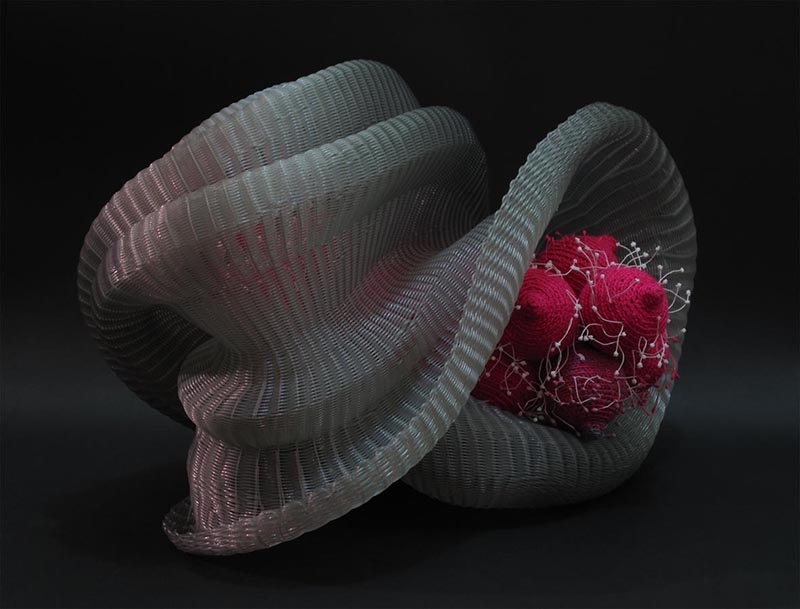
Pod
What inspires you? Take us through your process and continuous frameworks of reference.
I’m inspired by shape, colour, material and floating shapeless feelings that are hard to capture but must be tied down into three-dimensional form. I’m motivated to make beautiful biomorphic objects that balance male and female forms and hopefully induce curiosity and desire with a bit of wit thrown in.
I like to surround myself with a visual library of objects and books that I can draw inspiration from. I collect materials from the bush, street, hardware stores and fishing supplies shops. I watch and listen to as many art documentaries and podcasts as I can.
I start my morning with drawing or diary writing to warm my hands up and then continue with whatever I was working on last. I work on lots of pieces at once and after working on harder sculptures I reward myself by letting myself start something new. If I’m anxious or unfocused, I crochet fishing line or wire to be used in later works. Recently, I have taken up ceramics. I do it once or twice a week if I don’t have pressing deadlines, but find that ceramics can become all consuming if I let it.
Ernst Haeckel’s nature illustrations, the body inside and out, emotions, health and illness and how it affects the mind and body, nature, seeds, flowers, succulents, sea life, contemporary jewellery, contemporary fashion, Japanese basketry, Japanese ceramics, the concept of Wabi Sabi… all influence my work in various ways.
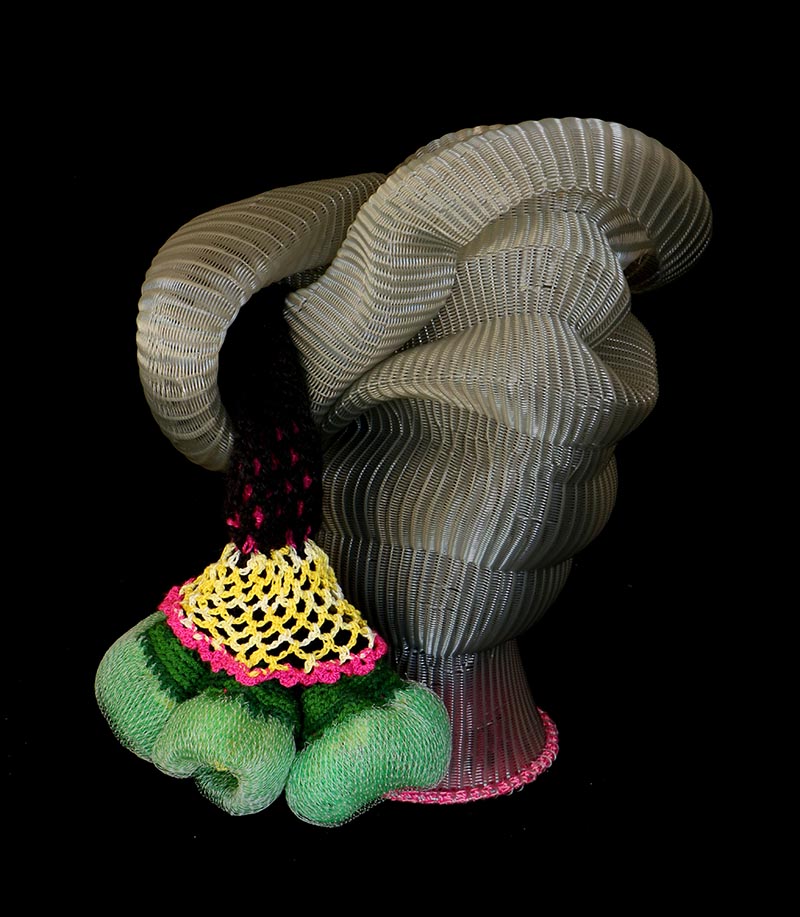
Sure Catch
What is the primary role of an artist? How do you see yourself in the context of challenging people’s perspectives via your work and art?
I don’t know if there is a primary role of an artist. The roles are varied. I guess in a broad sense it is to reflect the world around them back at the audience. I’m attracted to the fact there aren’t rules and regulations, and it’s up to me to make them up. Some artists are looking for political change, some to shock, and some to show beauty. I feel very lucky to be an artist. I wouldn’t want to live in a world without art.
What you want and what people get from your artwork is not always the same. I would like people to feel curious, to be amused, to be confused, and to be inspired.
I feel as an artist I am like a sponge constantly absorbing, filtering, digesting, and reinventing the information and images around me. I have made many sculptures over the years with titles that reference this ongoing interest.
How do you balance art and life?
I have always desired to live a life surrounded by art, artist and art-making and balance wasn’t something I started thinking about until I had my son. Now, life is a dance of adjusting and readjusting. The more I give to art the more I want to give to art. The never-ending tasks in life like housework just get pushed to the side. I always aim to create more balance but only maintain it for short periods of time. Art always wins.
I feel like my art life has been a series of stops and starts and new beginnings, I feel like every new move or life choice makes you “start again”. My professional life hasn’t been as straight forward as I imagined, more like two steps forward one step back – emerging, disappearing, remerging, flourishing, floundering, and back to the beginning.
I take what I do seriously and have strict working hours and lunch breaks which my family and friends respect. However, I have the flexibility to throw out plans when I want to. I try not to work on the weekends and keep that for family time.
I’m lucky as I’m not under any commercial pressure and make what I like. I do wish I had more room and endless amounts of money to explore bigger more ambitious projects!
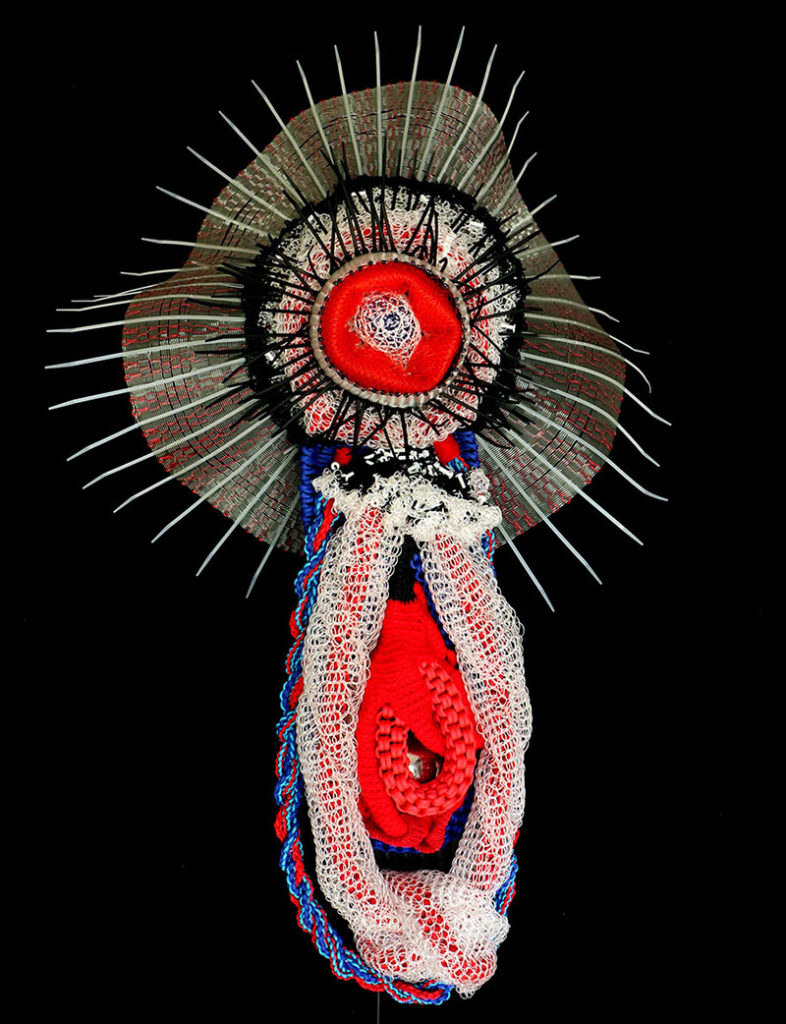
The moment before
How do you deal with the conceptual difficulty and uncertainty of creating work?
Uncertainty is what makes it exciting! Your instinct or a higher creative force will take over and work through you.
If I’m working on a certain theme I do as much research as I can during the process. I take notes and do working sketches and diagrams. I don’t often look back at these but the process of doing the research is usually enough to embed it in my mind.
I recently made a sculpture called Catching The Nebulous. This was about that difficult process of having a thought or image in your mind and trying to make it solid. I feel I often fail to catch my original thought, but my work moves onto something else. If you try to force an idea it often comes out looking that way.
How does your audience interact and react to the work?
I think with curiosity and an appreciation for the beauty they see. People often don’t understand the materials I’m working with and want to poke and squeeze the sculptures to better understand what they are looking at. I like the idea of producing objects of desire.
I can’t always anticipate how people will react to my work. I have twice had people who were suffering illnesses buy my work to make them feel better. One new collector cried with happiness when she purchased two sculptures.
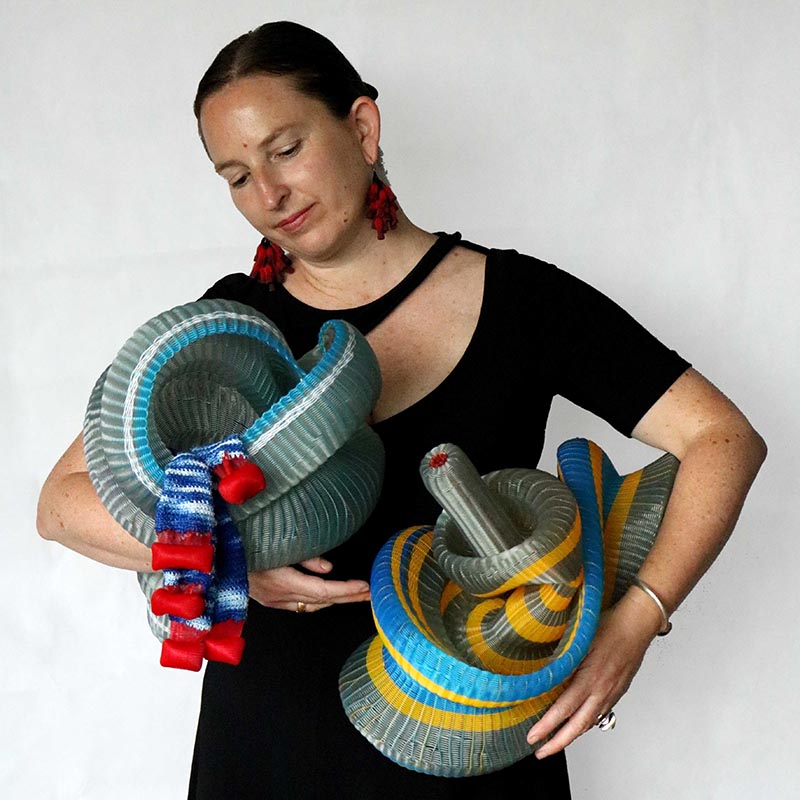
When you view the work of other artists what do you find interesting? Which shows, performances and experiences have shaped your creative process? Who are your maestros? Whose journey would you want to read about?
I’m looking for an emotional connection and a good sense of materiality. My tastes are broad, but sculpture, collage and painting on wood usually resonate with me the most. I love repetition and installations.
I’ve been lucky enough to travel and see a lot of great art so far. These are some of my stand-outs:
Annette Messenger’s soft sculpture organ installation and photos in the MCA, Fiona Hall’s sardine cans and money birds’ nests in the MCA, Bronwyn Oliver’s retrospective at Tarrawarra Museum of Art, Anish Kapoor at the MCA, Patrick Hall’s sculptural furniture in MONA (Museum Of Old And New Art), Bill Henson’s large apocalyptic nudes from the mid 90’s in Plimsoll Gallery, Yayoi Kusama sculptures in GOMA (Gallery of Modern Art, Brisbane) and at Naoshima, Frida Kahlo in the Art Gallery NSW, Del Kathryn Barton at the National Gallery of Victoria, Louise Bourgeois’ sculptures at Dia:Beacon in New York, Tony Cragg at the Museu Serralves in Portugal, El Anatsui’s wall hangings at Carriageworks, Nick Cave’s costumes and sculptures at the NGV and Carraigeworks.
Work I would love to see in the flesh: Kazuko Yamanaka’s brass wire crocheted forest, Eva Hesse’s sculpture from the 1960s, Bharti Kher’s bindi paintings and fibreglass whale heart sculpture, Subodh Gupta’s pots and pan sculptures, Ruth Asawa’s wire sculptures, Sopheap Pich’s bamboo sculptures, and Tzuri Gueta’s gallery in Paris.
I wish there were more contemporary artist biographies. I’m forever looking for books that don’t exist and, sometimes, toy with the idea of creating the book I want to read.
What have you observed about artists who are in flow?
It can be a tenuous thing. So, I find my friends who are in flow must isolate themselves for periods of time to maintain the flow. When you find the right flow, things seem to happen for you and doors open.
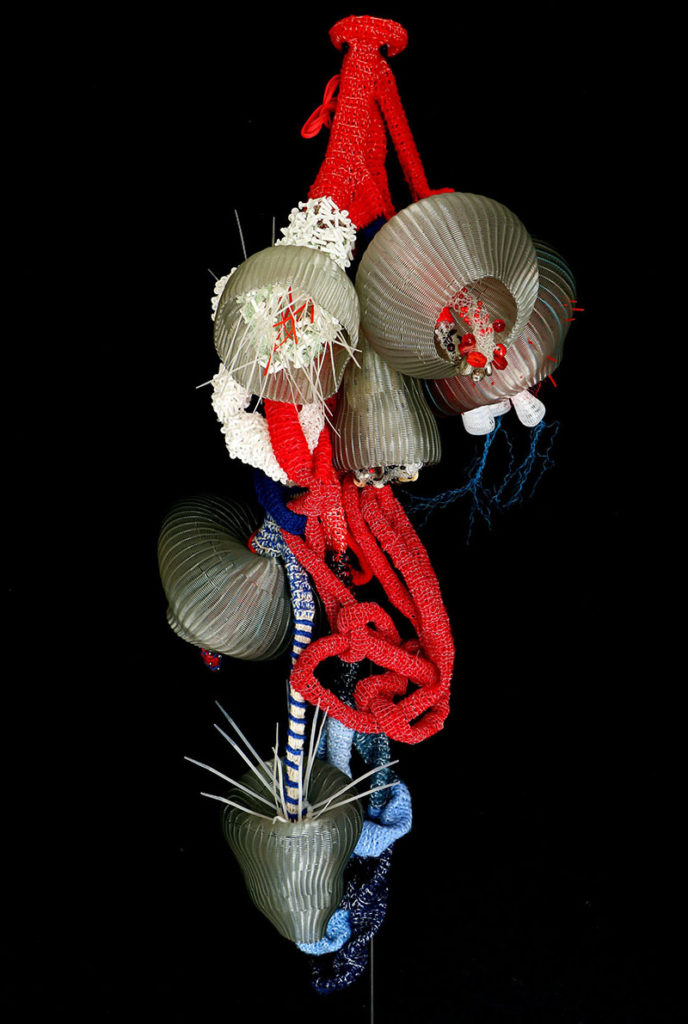
The hearts desire
What is that one thing you wished people would ask you but never do?
Can I buy them all now?!
What is the most important piece of advice you would give an artist who is starting out?
Be patient and don’t despair if things are slow or hard. Just keep on keeping on. You must put the time into your work and don’t expect everything you do to be brilliant. Sometimes you have to get the bad ones out of your system and learn from those mistakes before the good work can come. Be brave… Something I haven’t always been.
How does your interaction with a curator, gallery or client evolve from the initial interface, to the working-involvement-relationship? How do you feel about commissions?
It is wonderful to have other people’s observations and opinions and I’ve always had a lot of respect for galleries I’ve worked with. I have been asked to do commissions and usually say no, but have done some successfully at the suggestion of a gallery.
Being skilled at what I do doesn’t mean it’s easy for me to scale something up or repeat something. I find if my heart is not in it I can’t do it.
What are you working on now? What can we expect next?
I’ve been invited to put in a proposal for a public sculpture, which isn’t something I’ve done before, so I’m excited to work out how to translate my current visual language into a new format and material.
There is a possible overseas residency on the cards and I am working on a large-scale installation for an exhibition. I’m joining up with an architect to design a range of lights.
As told to Sonalee Tomar for The Indian Curator











Add Comment